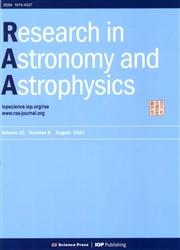GRANDProto300粒子探测器阵列性能的仿真研究
IF 2.8
4区 物理与天体物理
Q3 ASTRONOMY & ASTROPHYSICS
引用次数: 0
摘要
巨型射电中微子探测阵列(GRAND)是一个被提议的大型天文台,旨在探测能量超过100 PeV的宇宙射线、伽马射线和中微子。GRANDProto300实验被提议作为GRAND项目的早期阶段,由无线电天线和闪烁探测器的混合阵列组成。后者作为一种成熟的传统探测器,用于交叉检查从射电观测中选择的候选事件的性质。本研究基于Geant4软件包开发了G4GRANDProto300仿真软件,对闪烁体探测器阵列的间距进行优化,并对其有效面积进行研究。在300 m、500 m、600 m、700 m和900 m的不同探测器间距下,进行了不同天顶角的分析。结果表明,对于GRAND项目中用于大天顶角搜索宇宙射线的探测器,最佳有效面积为探测器间距为500 m。我们开发的G4GRANDProto300软件可以在今后的工作中进一步优化粒子探测器阵列的布局。本文章由计算机程序翻译,如有差异,请以英文原文为准。
Study on the Performance of the GRANDProto300 Particle Detector Array by Simulation
Abstract The Giant Radio Array for Neutrino Detection (GRAND) is a proposed large-scale observatory designed to detect cosmic rays, gamma rays, and neutrinos with energies exceeding 100 PeV. The GRANDProto300 experiment is proposed as the early stage of the GRAND project, consisting of a hybrid array of radio antennas and scintillator detectors. The latter, as a mature and traditional detector, is used to cross-check the nature of the candidate events selected from radio observations. In this study, we developed a simulation software called G4GRANDProto300, based on the Geant4 software package, to optimize the spacing of the scintillator detector array and to investigate its effective area. The analysis was conducted at various zenith angles under different detector spacings, including 300 m, 500 m, 600 m, 700 m, and 900 m. Our results indicate that, for large zenith angles used to search for cosmic-ray in the GRAND project, the optimized effective area is with a detector spacing of 500 m. And the G4GRANDProto300 software that we developed could be used to further optimize the layout of the particle detector array in future work.
求助全文
通过发布文献求助,成功后即可免费获取论文全文。
去求助
来源期刊

Research in Astronomy and Astrophysics
地学天文-天文与天体物理
CiteScore
3.20
自引率
16.70%
发文量
2599
审稿时长
6.0 months
期刊介绍:
Research in Astronomy and Astrophysics (RAA) is an international journal publishing original research papers and reviews across all branches of astronomy and astrophysics, with a particular interest in the following topics:
-large-scale structure of universe formation and evolution of galaxies-
high-energy and cataclysmic processes in astrophysics-
formation and evolution of stars-
astrogeodynamics-
solar magnetic activity and heliogeospace environments-
dynamics of celestial bodies in the solar system and artificial bodies-
space observation and exploration-
new astronomical techniques and methods
 求助内容:
求助内容: 应助结果提醒方式:
应助结果提醒方式:


